Ultimate Namibia Under Canvas Safari
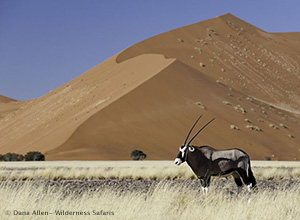
Duration: 10 days
Area: Etosha National Park, Damaraland, Swakopmund, Sossusvlei
Style: True African Safari
Comfort Level:![]()
![]()
![]()
![]()
![]()
This safari is designed to offer a true “back to nature” experience with the emphasis being on the experiential aspect of safaris. We have identified a strong desire in many guests to go back to the roots of safari, to touch, to smell, to feel and to experience the wild, with one’s feet firmly in the dust that covers Africa. This is an experience that is exclusive in the real sense of the word, as well as being very much away from the pressures of ‘normal’ life!
Since most of the camps on this safari are semi-permanent and seasonal, there is a degree of compromise required concerning some of the frills and other ‘add-ons’ that you might expect in a permanent tented camp or lodge, but there is still a strong focus on ensuring guests’ comfort. Those prepared to forego some conventional ‘necessities’, so that they are unencumbered by buildings and all the paraphernalia that goes with them, will be able to go to sleep hearing only the noisy silence of the desert and to wake up to a chorus that announces the start of a new day. It is the kind of intimacy that can only be achieved by taking guests to the most wild, remote and private places, and giving them access to exclusive areas away from the beaten path.
Highlights:
- Travel with one of Namibia’s most reputable and well-known naturalist guides.
- Visit the world renowned AfriCat Foundation and learn more about conservation initiatives involving Africa’s large cats.
- Sleep under canvas in the tree tops overlooking one of the most productive waterholes on the Onguma Private Game Reserve.
- Memorable and exciting guided game drives within the renowned Etosha National Park, from the vantage point of a specially modified, air conditioned 4x4 with pop tops.
- Explore the Damaraland region whilst staying at the exclusive-use //Huab Under Canvas.
- Search for desert adapted elephant in ephemeral river systems.
- Track for the endangered black rhino in conjunction with Save the Rhino Trust.
- Visit and explore Namibia’s central coastal region with canyons, dunes and lagoons.
- Explore the private Namib Tsaris Conservancy on exploratory nature drives and guided walks whilst staying in the exclusive-use Sossus Under Canvas.
- Climb some of the world’s highest free-standing sand dunes at Sossusvlei and enjoy a magic box picnic in the Namib Naukluft Park afterwards.
- Enjoy spectacular star gazing of the Milky Way on the Namib Tsaris Conservancy.
- Enjoy refreshing moments in desert pools on the Namib Tsaris Conservancy.
Low Season: April, May, June & November
High Season: July, September & October
| Day 1, 2 & 3 | Arrive in Windhoek by 08h00 or the previous day. Set off by road to Onguma Tree Tops, Eastern Etosha National Park boundary via the Okonjima Day Visitor Centre, AfriCat Foundation |
| Day 4, 5 & 6 | Drive to //Huab Under Canvas, Damaraland |
| Day 7 | Drive to Desert Breeze Lodge, Swakopmund |
| Day 8 & 9 | Drive to Sossus Under Canvas, Sossusvlei |
| Day 10 | Drive back to Windhoek |
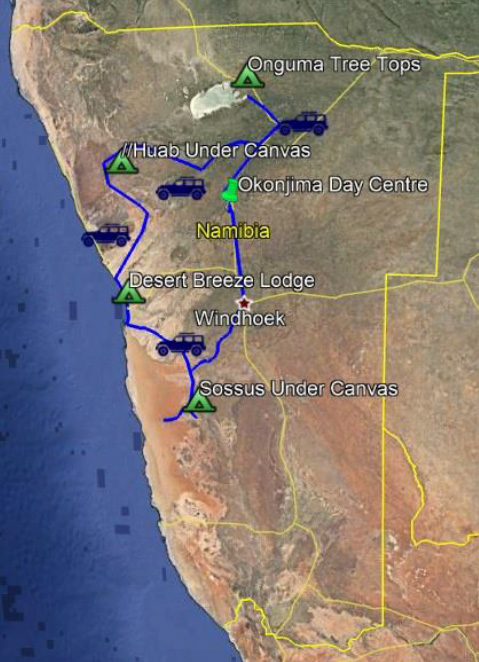
Detailed Itinerary
Day 1: Windhoek to Eastern Etosha National Park via Okonjima
This morning Ultimate Safaris will collect you from your various accommodation establishments or from the Windhoek International Airport (assuming you land before 07h00). You then depart Windhoek in your safari vehicle with your private guide and set off on your journey.
On your way to Onguma Tree Tops you will visit the Okonjima’s AfriCat Day Centre, a wonderful highlight with which to start your safari. Okonjima is home to the AfriCat Foundation, a wildlife sanctuary which focuses on the research and rehabilitation of Africa's big cats, especially injured or captured leopard and cheetah. You will arrive in time to embark on an exciting and informative game drive and tour of the centre. Here you will learn about the function and vision of the AfriCat Foundation and will also get to meet some of the Foundation’s special captive carnivore ambassadors.
PLEASE NOTE: There will be no tracking of wild cats on this visit and should that be required a pre-overnight extension should be booked.
After the excursion you will enjoy a light lunch before you journey continues further north via the small towns of Otjiwarango, Otavi and Tsumeb arriving at Onguma in the late afternoon. You will have time to freshen up and relax before dinner and the official safari briefing with your guide.
Onguma Tree Top Camp: Tree Top is a unique and beautiful camp, situated on the Onguma Game Reserve, adjacent to the Eastern side of Etosha National Park. It is a small and intimate camp, especially designed for those travellers who would like to truly experience the bush in all its raw splendour. This Camp is built on wooden stilts amongst the tree tops with full views over one of the most beautiful watering holes on the Reserve. The Camp consists of 4 thatched wooden rooms, and a main complex. Thus the camp is ideal for a small group of guests, or simply a group of family or friends longing for a private getaway.
The main complex is where we would like our guests to feel this is their home away from home. It is completely open towards the front where the waterhole is situated, but also has the option of letting down canvas sides if the weather conditions require that. Relax in the comfortable lounge or in front of the fire place enjoying your favourite beer or glass of red wine. The kitchen is open plan and the chef will spoil you with wonderful dishes cooked on an open fire. The Boma area steps off of the lounge deck, where our guests may sit for hours watching the animals and birds that frequent the hole throughout the day.
The 4 thatched rooms are designed in such a way that once again all is open on all sides to allow you to enjoy the view and animals all the time, but also with canvas sides that can be put down. Crisp linen, down duvets, cozy throws to keep you warm at night, your own private toilet and wash up area, as well as a wonderful private outside shower. A private deck in front of your room is available to relax on and enjoy exactly the same views as from the main area’s deck. Tree Top is a place to savour, small bits at a time - this is a special place you will not want to leave.
Overnight: Onguma Tree Top Camp
Breakfast, Lunch, Dinner & Okonjima AfriCat visit (local drinks included)
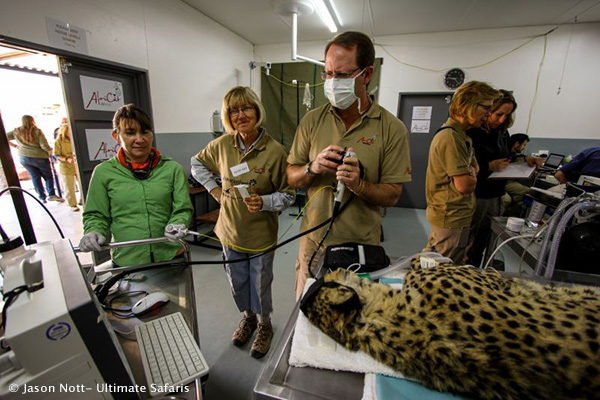
Day 2: Eastern Etosha National Park
Today is full of exciting game viewing within the eastern section of Etosha National Park, with the option to go on across towards Halali or to concentrate on the areas closer to Namutoni and north to Fischer’s Pan. You also have the option to return to the camp for lunch, or spend the entire day in the park to maximize your game viewing experience.
Etosha National Park: Etosha National Park, translated as the ‘Place of Mirages’, Land of Dry Water’ or the ‘Great White Place’, covers 22 270 km², of which over 5,000 km² is made up of saline depressions or ‘pans’. The largest of these pans, the Etosha Pan, can be classified as a saline desert in its own right. The Etosha Pan lies in the Owambo Basin, on the north-western edge of the Namibian Kalahari Desert. Until three million years ago it formed part of a huge, shallow lake that was reduced to a complex of salt pans when the major river that fed it, the Kunene, changed course and began to flow to the Atlantic instead. If the lake existed today, it would be the third largest in the world. Etosha Pan is the largest of the pans at 4 760 km² in extent. It is nowadays filled with water only when sufficient rain falls to the north in Angola, inducing floods to flow southward along the Cuvelai drainage system. The Park consists of grassland, woodland and savannah.
Game-viewing centers around the numerous springs and waterholes where several different species can often be seen at one time. The Park boasts some 114 mammal and over 340 bird species. Wildlife that one might see includes elephant, lion, giraffe, blue wildebeest, eland, kudu, gemsbok (oryx), zebra, rhino, cheetah, leopard, hyena, honey badger and warthog, as well as the endemic black faced impala.
Overnight: Onguma Tree Top Camp
Breakfast, Lunch, Dinner and Etosha Game Drives with Guide (local drinks included)
Day 3: Etosha National Park / Onguma Game Reserve
Another morning dedicated to memorable game drives within the eastern section of Etosha National Park with your guide. You return to camp for lunch and an early afternoon rest, spending your final afternoon on a shared game drive with a local guide on the private Onguma Game Reserve, culminating in a sundowner overlooking Fischer’s Pan. You then return after sunset with enough time to freshen up and enjoy your final ‘safari dinner’ overlooking the camp’s floodlit waterhole.
Onguma Game Reserve: Situated on the eastern side of Etosha National Park and bordering Fisher’s Pan, Onguma Game Reserve has more than 20,000 hectare of protected land and wildlife. The nature reserve boasts over thirty different animal species consisting of plains game such as kudu, giraffe, eland, oryx, hartebeest, zebra, impala and many more roam freely, as well as predators such as lion, cheetah and leopard, being common residents of the area. Onguma Game Reserve is now proud to be home to a family of black rhinos! More than 300 bird species can also be viewed at Onguma Game Reserve.
Overnight: Onguma Tree Top Camp
Breakfast, Lunch, Dinner, AM Etosha & PM Onguma Drive (local drinks included)
Day 4: Drive from Eastern Etosha National Park to Damaraland
This morning after breakfast you will continue your safari to the heart of Namibia, Damaraland, traveling through farmlands and the small towns of Tsumeb, Otavi, Outjo and Khorixas.
Damaraland is typified by displays of colour, magnificent table topped mountains, rock formations and bizarre-looking vegetation. The present-day landscape has been formed by the erosion of wind, water and geological forces which have formed rolling hills, dunes, gravel plains and ancient river terraces. It is the variety and loneliness of the area as well as the scenic splendour which will reward and astound you, giving one an authentic understanding of the word 'wilderness'.
You enjoy a delicious Magic Box picnic en route and arrive in time in time to enjoy fireside sundowners at your exclusive //Huab Under Canvas. Please note that today is a long day of travelling, rewarded with another 3 night stay at your next camp.
//Huab Under Canvas: //Huab Under Canvas is located in a core desert adapted black rhino area in the //Huab Conservancy in Damaraland, approximately 90 km north west of Khorixas, and it is nestled in a grove of Mopane trees on the banks of a tributary of the //Huab River. Protected from all the prevailing winds and sun, the semi-mobile camp is virtually invisible from anywhere around and it carries arguably the lowest environmental footprint of any camp in Namibia. The camp is non-participatory and is serviced and equipped to ensure that guests can stay in great comfort while allowing them to relax and revel in the feeling of space and solitude that makes Namibia so special. Good food and wine are an important part of the overall experience, so our camp catering is of a suitably high standard - even in dry, desolate areas where this can be hard to maintain. Our camp chefs have their own unique specialties so delicious, wholesome meals and local delicacies are prepared for each meal using fresh local produce wherever possible. Tents are raised on mobile platforms and have basic infrastructure that allows for important comforts such as en suite flush toilets, but the essence of the camp remains Under Canvas, mobile and experiential.
With provision for up to eight tents, this camp is booked on an exclusive basis for each group staying in it. Our Under Canvas camps use large rectangular Meru tents (4m x 3m and 2.5 m high) with built in groundsheets and mosquito screens on all doors and windows. Each spacious tent is equipped with standard height camp beds, solar lighting, and storage for clothing and other belongings that need to be accessible. Each also has a bathroom which has its own toilet, bucket shower and washbasin. A small table, mirror, towels and toiletries as well as solar lighting are also provided in the bathroom, and chairs on the patio allow guests to relax and enjoy the surrounding view.
Activities include tracking desert adapted rhino which is completely private and done in an area that has the highest tracking success rate in north western Namibia; exploring the upper and less crowded //Huab River in search of desert adapted elephants; nature walks and scenic game drives.
Overnight: //Huab Under Canvas
Breakfast, Lunch, Dinner and nature based activities with Guide (local drinks & limited laundry included)
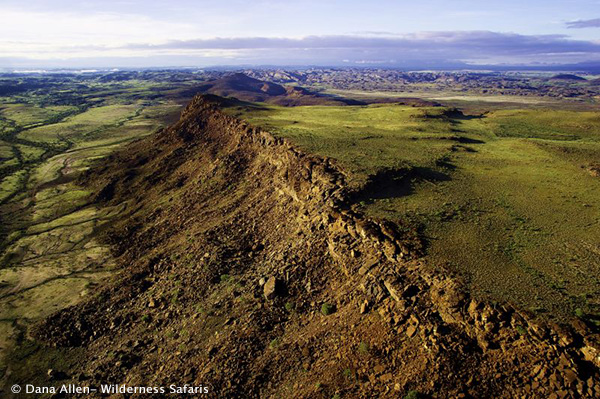
Day 5: Damaraland
Today you will spend an exciting and memorable morning out rhino tracking with the assistance of local trackers. It is worth noting that these black rhino form part of one of the only free-roaming black rhino populations in Africa and tracking animals in an unfenced and uninhibited environment is an absolute privilege. You will return to camp for a freshly prepared lunch and with time to relax at camp during the heat of the day. Later in the afternoon you head out again for a scenic nature drive or walk to explore this vast and astounding ecosystem. //Huab Under Canvas works together with the Save the Rhino Trust (SRT) - an NGO that has been has been instrumental in the preservation of the rare, endangered, desert adapted black rhino. Having barely survived the slaughter in many parts of Africa during the '80s and '90s, the black rhino population of Namibia increased substantially since the formation of SRT.
Desert Black Rhinoceros: Namibia is home to the larger of two subspecies of the black rhinoceros found in southern Africa. The only population that remains in the wild, unfenced and outside reserves occupies an arid range in the western Kaokoveld. Their preferred habitat is the mountainous escarpment, but they follow ephemeral rivers into the northern Namib as well, especially when conditions are favorable after rains. They are the only black rhinoceros in Africa that are internationally recognized as a “desert group”. Like desert-adapted elephant, they cover great distances. They walk and feed at night and rest during the day. To meet their nutritional and bulk requirements they browse on no fewer than 74 of the 103 plant species that grow in their range. One of the few animals to eat fibrous Welwitschia leaves; they even feed heavily on the milkbush (Euphorbia virosa) with its sharp spines and toxic latex, presumably because of the high water and fat content. They are physical defenses of dryland plants without apparent harm. Once widespread in the subcontinent, black rhinoceros are an endangered species. The smaller subspecies, Diceros bicornis minor, does not range into Namibia.
Overnight: //Huab Under Canvas
Breakfast, Lunch, Dinner and nature based activities with Guide (local drinks & limited laundry included)
Day 6: Damaraland
Today you continue your adventures exploring Damaraland, enjoying the freedom to discover the fascinating landscapes with your private naturalist guide both by vehicle and on foot. Damaraland is a surprising refuge for desert adapted wildlife that may include elephant, giraffe, oryx, springbok and even some predators such as lion. However, as with any wildlife sightings in Namibia, this depends on many factors including seasonality so specific sightings are never guaranteed. The wildlife roams large tracks of unfenced desert landscapes and finding game can be challenging, but this is all part of the adventure of exploring this wild untouched gem of Namibia. Today’s focus will be largely on tracking the elusive desert adapted elephants in the ephemeral river systems, an activity which will mean spending most of the day out. Your guide will take along a delicious picnic lunch and you will return to camp in the late afternoon.
Desert Adapted Elephant: In habitats with sufficient vegetation and water an adult elephant consumes as much as 300 kg of roughage and 230 liters of water every day of its life. Consider what a herd of them would eat and drink in a week or a month or a year. African elephant in a desert? Well, yes! Not only elephant, but other large mammals like black rhinoceros and giraffe as well. Their ranges extend from river catchments in northern Kaokoveld as far south as the northern Namib. Apart from the Kunene River, seven river courses northwards from the Ugab provide them with possible routes across the desert, right to the Skeleton Coast. The biggest are the Hoarusib, the Hoanib, the Huab and the Ugab Rivers. Desert adapted elephant in Kaokoland and the Namib walk further for water and fodder than any other elephant in Africa. The distances between waterholes and feeding grounds can be as great as 68 km. The typical home range of a family herd is larger than 2,000 km², or eight times as big as ranges in central Africa where rainfall is much higher. They walk and feed at night and rest during the day. To meet their nutritional and bulk requirements they browse on no fewer than 74 of the 103 plant species that grow in their range. Not a separate species or even a subspecies, they are an ecotype unique to Namibia in Africa south of the equator, behaviorally adapted to hyper-arid conditions. Elephant in Mali on the southwestern fringe of the Sahara Desert are the only others known to survive in similar conditions.
Overnight: //Huab Under Canvas
Breakfast, Lunch, Dinner and nature based activities with Guide (local drinks & limited laundry included)
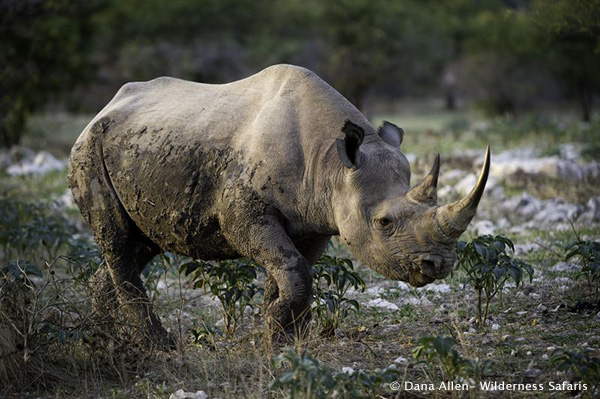
Day 7: Damaraland to Swakopmund
After an early breakfast and departure the drive today takes you south past Namibia’s highest mountain, the Brandberg which peaks at 2,573 m above sea level, and west to meet the coast at Henties Bay. You then continue south to the coastal town of Swakopmund where you can enjoy the pleasant seaside location and cooler coastal air for the night. You stay on the eastern outskirts of the town, overlooking the Swakop River valley and desolate desert dune landscapes. Tonight includes dinner at a popular restaurant which specializes in locally harvested fresh seafood as well as other local and international dishes.
Swakopmund: Swakopmund resembles a small, German coastal resort nestled between the desert and the sea. It boasts a charming combination of German colonial architecture blended with good hotels, shops, restaurants, museums, craft centres, galleries and cafés. Swakopmund had its beginnings as a landing station in 1892 when the Imperial Navy erected beacons on the site. Settlers followed and attempts to create a harbour town by constructing a concrete Mole and then iron jetty failed. The advent of World War 1 halted developments and the town sank into decline until half a century later when infrastructures improved and an asphalt road opened between Windhoek and Swakopmund. This made reaching the previously isolated town quicker and easier and it prospered once again to become Namibia’s premier resort town. Although the sea is normally cold for swimming there are pleasant beaches and the cooler climate is refreshing after the time spent in the desert.
Desert Breeze: Located on the banks of the ephemeral Swakop River and just a few minutes' drive from the centre of town, Desert Breeze provides the perfect escape to experience space, tranquility and serenity. There are twelve en-suite, luxury bungalows and one exquisite villa, each with a private sun deck to admire the breath-taking view of the dunes. Expressing sophisticated style and luxury from their accommodation right through to their breakfast facilities makes guests feel pampered and spoiled. Each bungalow and villa is equipped with wireless internet, mini bar, coffee and tea making facilities and digital safes. Only the freshest of produce is provided for breakfast and seating is available indoors or on the deck for guests to enjoy the view and peaceful atmosphere. Big basalt sculptures along with colourful and very unique architecture stand in contrast to the desert landscape, yet also compliments it. The creative luxury offered in the bungalows along with the friendly staff will make your stay very memorable.
Overnight: Desert Breeze
Breakfast, Lunch & Dinner (local drinks included)
Day 8: Swakopmund to Namib Tsaris Conservancy, Sossusvlei
After an early breakfast you depart on a fascinating drive which takes you south-east through awesome and ever-changing desert landscapes via the impressive Gaub and Kuiseb canyons to meet the dunes at the settlement of Solitaire. A picnic lunch will be had en route and you will continue onto the Namib Tsaris Conservancy, where you will spend your final two nights of your safari at the exclusive-use Sossus Under Canvas. Arrival should be in the mid to late afternoon with enough time to acquaint yourself with the camp and enjoy a hot bucket shower before dinner.
NOTE: As an alternative to the drive from Swakopmund to Sossusvlei you may like to take a scenic light aircraft flight over Sossusvlei and along the Diamond Coast (optional extra at additional cost), allowing you a bird’s eye view over the Sandwich Harbour and salt pans, the Namib Sea Sand, abandoned mining camps and two shipwrecks,. Your guide will drive to meet up with you in Sossusvlei later in the day. Please note that if making use of this offer, flights will need to be booked exclusively with Ultimate Safaris for absolute logistical reasons.
Namib Tsaris Conservancy: The 24 000 hectare Namib Tsaris Conservancy was founded by Landscape Conservationist and Philanthropist Swen Bachran in 2010, and it serves as a natural buffer from the harshest desert conditions and a refuge that is vital to wildlife through the dry season. Eight years of intensive work to reverse sixty years of inappropriate farming practices, including the removal of 120 km of internal fencing, the installation of wildlife watering points, the improvement of road networks, the rehabilitation of land and the reintroduction of wildlife that historically occurred here, has resulted in one of the most picturesque and ecologically sound tracts of land in the area. The Conservancy has gravel plains, mountainous areas with dry river valleys as well as a large raised plateau which towers above the desert below, and it is now home to some of largest concentrations of wildlife in the area, including oryx, springbok, Hartmann’s mountain zebra, Burchell’s zebra, kudu, hartebeest, giraffe, steenbok, klipspringer, bat-eared fox, and aardwolf, as well as predators such as leopard, cheetah, brown and spotted hyena. Plans for the future which include the reintroduction of critically endangered black rhino and the acquisition of adjoining land are already well underway!
Sossus Under Canvas: Located on the private 24,000ha Namib Tsaris Conservancy and nestled between the Nubib and Zaris Mountains, this camp is a mere thirty minutes’ drive from the Sossusvlei gate, the gateway to the Great Namib Sand Sea which has recently been declared a UNESCO World Heritage Site. The camp offers eight tents, two of which are family units, and is open seasonally between April and November, offering a fantastic alternative to any traditional lodge in the Sossusvlei area as it also offers exclusivity which is beyond compare. Activities include visits to Sossusvlei with your private guide and general exploration of the private Neuhof Nature Reserve, including nature walks and drives, magic moments in desert pools (yes, isn’t that intriguing) and star gazing. In addition to this, Sossus Under Canvas provides a convenient base from which to go on hot air balloon flights as well as scenic helicopter and fixed wing aircraft flights over the local area. It is also a great venue for photographers, offering fantastic landscapes, iconic quiver trees, and the opportunity for night time photography which is often very difficult to arrange elsewhere.
Overnight: Sossus Under Canvas
Breakfast, Lunch, Dinner and nature based activities with Guide (local drinks included)
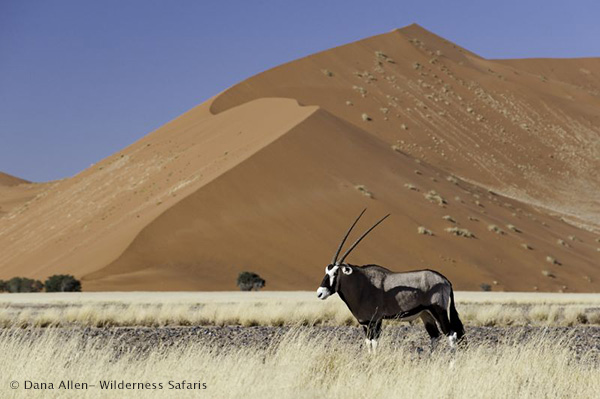
Day 9: Namib Tsaris Conservancy / Sossusvlei
This morning you will need to rise early for a magical excursion with your guide in the Namib Naukluft National Park, normally setting off before sunrise to enter the park at sunrise and capture the dunes whilst the light is soft and shadows accentuate the towering shapes and curves. This area boasts some of the highest free-standing sand dunes in the world and your guide will give you an insight on the formation of the Namib Desert and its myriad of fascinating creatures and plants that have adapted to survive these harsh environs. Once you have explored Sossusvlei, Deadvlei and surrounding dune fields to your heart’s content you can enjoy a relaxed picnic brunch in the shade of a camel thorn tree.
You will return to camp for a late freshly prepared lunch and with time to relax at camp during the heat of the day. Later in the afternoon you head out again for a scenic nature drive or walk to explore this vast and astounding ecosystem and to enjoy a magnificent final safari sundowner.
Sossusvlei: This most frequently visited section of the massive 50,000 km² Namib Naukluft National Park has become known as Sossusvlei, famous for its towering apricot coloured sand dunes which can be reached by following the Tsauchab River valley. Sossusvlei itself is actually a clay pan set amidst these star shaped dunes which stand up to 300 meters above the surrounding plains, ranking them among the tallest dunes on earth. The deathly white clay pan contrasts against the orange sands and forms the endpoint of the ephemeral Tsauchab River, within the interior of the Great Sand Sea. The river course rises south of the Naukluft Mountains in the Great Escarpment. It penetrates the sand sea for some 55 km before it finally peters out at Sossusvlei, about the same distance from the Atlantic Ocean. Until the encroaching dunes blocked its course around 60,000 years ago, the Tsauchab River once reached the sea; as ephemeral rivers still do in the northern half of the Namib. Sand-locked pans to the west show where the river previously flowed to before dunes shifted its endpoint to where it currently gathers at Sossusvlei.
Roughly once a decade rainfall over the catchment area is sufficient to bring the river down in flood and fill the pan. On such occasions the mirror images of dunes and camel thorn trees around the pan are reflected in the water. Sossusvlei is the biggest of four pans in the vicinity. Another, famous for its gnarled and ghostly camel thorn trees, is Deadvlei which can be reached on foot over 1 km of sand. Deadvlei’s striking camel thorn trees, dead for want of water, still stand erect as they once grew. They survived until about 900 years ago when the sand sea finally blocked the river from occasionally flooding the pan.
Overnight: Sossus Under Canvas
Breakfast, Lunch, Dinner and nature based activities with Guide (local drinks included)
Day 10: Namib Tsaris Conservancy to Windhoek
After a leisurely breakfast this morning you will depart from Sossusvlei and return to Windhoek, driving northeast up the Great Escarpment and through the scenic Khomas Hochland highlands. A tasty picnic lunch will again be served en route and arrival in Windhoek should be by the mid-afternoon.
Upon your arrival in Windhoek you will be transferred to your accommodation establishment of choice, or out to the Windhoek International Airport (transfer to be booked additionally) if flying out in the evening - departure flights must be no earlier than 18h00 to allow sufficient time for the journey back to Windhoek, or a final night in Windhoek can be arranged at additional cost if required. A final night in Windhoek is highly recommended!
Breakfast & Lunch
OPTIONAL POST SAFARI EXTENSION TO WOLWEDANS:
You have the option to extend your safari for an additional two nights at Wolwedans Dunes Lodge, located on one of the largest private nature reserves in the world, NamibRand Nature Reserve, an awe-inspiring desert landscape of red dune fields and champagne colored plains.
Arrangements include a scenic land transfer from Sossus Under Canvas to Wolwedans and a scheduled air taxi from Wolwedans to Windhoek International Airport.
NOTE: To make use of this post-safari extension, please be aware that the air taxi arrives back at the Windhoek’s Hosea Kutako International Airport at 10h45 and again at 15h15. You need to book flights departing after 13h00 or after 17h15 respectively from the Windhoek International Airport to allow for a 2 hour check-in time.
Day 1, 2 & 3: Onguma Tree Tops, |
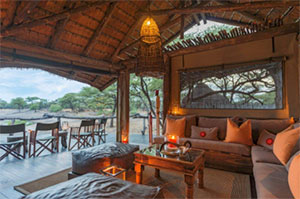 |
Day 4, 5 & 6: //Huab Under Canvas, |
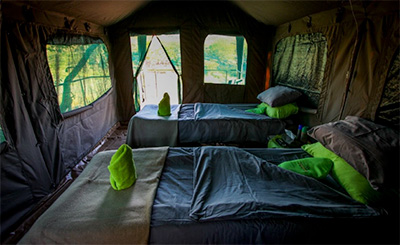 |
Day 7: Desert Breeze Lodge, |
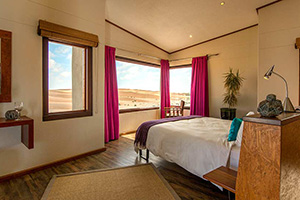 |
Day 8 & 9: Sossus Under Canvas, |
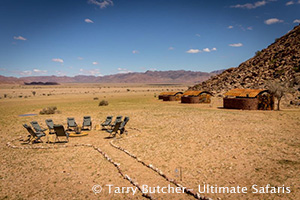 |




